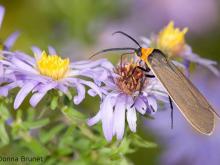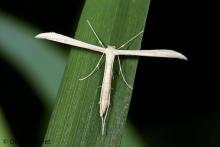Land Invertebrates
Media

Species Types
Scientific Name
Anax junius
Description
The common green darner is abundant and well-known for its bright green, blue, and purple colors. A large dragonfly up to 3 inches long, it is a migratory species that travels south in autumn.
Media

Species Types
Scientific Name
Erythemis simplicicollis
Description
The eastern pondhawk is a common and well-known large dragonfly of ponds and other standing water. Females are green with dark-banded abdomen. Mature males are blue with green face and thorax.
Media

Species Types
Scientific Name
Libellula cyanea
Description
The spangled skimmer grows to nearly 2 inches long. Each of the 4 wings has a white spot beside a black spot on the outer leading edge. Males are blue with a dark head. Females are dark brown with lengthwise yellow stripes.
Media

Species Types
Scientific Name
Pachydiplax longipennis
Description
Blue dasher males and females look quite different. Both have a white face, a black abdomen tip, and slanted black and yellow stripes on the thorax. But males are blue and females are striped black and yellow.
Media

Species Types
Scientific Name
Ladona deplanata
Description
The male blue corporal has a rather dark blue body, a black head, and dark marks at the wing bases. Females and young males are brownish and have two short "corporal" stripes on the side of the thorax, behind the eye.
Media

Species Types
Scientific Name
Libellula incesta
Description
The slaty skimmer has a body about 2 inches long. Older males are all slate blue with black heads. Young males and females have brown abdomens and a dark stripe running down the back.
Media

Species Types
Scientific Name
Libellula pulchella
Description
The twelve-spotted skimmer has twelve brown wing spots. Males, like this one, have eight additional spots that are white. Females lack the white spots.
Media

Species Types
Scientific Name
Entypus aratus, E. unifasciatus, E. fulvicornis, and others
Description
Spider wasps in genus Entypus are bluish black and usually have some amount of amber color on their dark, smoky wings. Some species have bright yellow antennae.
Media

Species Types
Scientific Name
Cinindela sexguttata
Description
The six-spotted tiger beetle is probably the most familiar tiger beetle in Missouri. It’s most often seen in spring, as it darts in and out of trails just ahead of hikers.
Media

Species Types
Scientific Name
Phanogomphus graslinellus
Description
The pronghorn clubtail is one of several members of its genus in our area that are generally difficult to identify. Like other dragonflies, it is an aerial predator that hunts insects on the wing.
See Also



Media

Species Types
Scientific Name
Cisseps fulvicollis
Description
The yellow-collared scape moth is more often “orange-collared.” And whether you think it looks more like a firefly or a wasp, it’s still a moth!
Media

Species Types
Scientific Name
Nearly 150 species in North America north of Mexico
Description
Slim, delicate plume moths are instantly recognizable by their T-shaped silhouette, long legs, and muted shades of tan and brown. It can be hard to separate the various species.
Media

Species Types
Scientific Name
Pyrrharctia isabella
Description
Not many people know the adult Isabella tiger moth when they see one, but we’re all acquainted with its caterpillar, the woolly worm, or woolly bear.
About Land Invertebrates in Missouri
Invertebrates are animals without backbones, including earthworms, slugs, snails, and arthropods. Arthropods—invertebrates with “jointed legs” — are a group of invertebrates that includes crayfish, shrimp, millipedes, centipedes, mites, spiders, and insects. There may be as many as 10 million species of insects alive on earth today, and they probably constitute more than 90 percent all animal species.





















